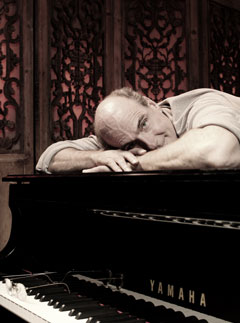


James Taylor may be America's most beloved singer-songwriter--in fact, they more or less coined the term just to describe his warm, introspective folk-rock. Over the course of a 40-year career Taylor has sold over 80 million albums, and his Greatest Hits is one of the best-selling discs of all time.
Some people definitely have called my guitar style 'pianistic.' I know I've definitely gotten into trouble with the hootenanny police on more than one occasion.
Despite such massive numbers, Taylor chose to think small for his latest series of concerts. The One Man Band Tour features only James and his guitar--plus a bit of help from Larry Goldings, the "band" on the tour and Taylor's keyboardist of choice for the last five years. Larry and James sat down backstage before a recent show at Nashville's Ryman Theater to talk about the piano's longtime supporting role in Taylor's music.
It's supposed to be a one-man show. Why are there two of you here?
Taylor: It's not a one-man show--it's a one-man band show, and Larry's the band! [Laughs.] There's me and my guitar, and Larry on piano. And you have to have piano! Piano is the single instrument that can best focus an entire piece of music. It's the fundamental training for all musicians. You get an awful lot of music out of a piano.

You play piano yourself, don't you?
Taylor: I've written a number of songs on piano--usually about one song per record. "Sun on the Moon" was one. "Shed a Little Light" was another. Going way back, there was "Ladies in My Life," a song I should probably know better than to take credit for. "There We Are" was a piano song. So was "Back on the Highway." The problem is, I don't play piano well enough to perform the songs in real time onstage. I need someone else to help me.
So how do you make linear guitar parts and linear piano parts work together?
Larry Goldings: It's tricky. I come from a jazz background, and in jazz, the combination of piano and acoustic guitar takes great sensitivity. Hopefully, the musicians have a discussion beforehand about who's going to cover which territory. That's true into this context too. I'm constantly trying to figure out how to be supportive without getting in James's way. He certainly covers a lot of ground with just his guitar playing and singing! So I tend to think of my role as providing support in the lower register while adding variations in color throughout the set. It's a fun challenge!
So many of your records rely on the pristine sound of an acoustic piano.
Taylor: The keyboard sounds on my records have a lot to do with what the musicians decided to play. For example, I did That's Why I'm Here at a time when synthesizers were becoming ubiquitous, and Billy Payne loved the possibilities of the Yamaha DX7. But my attitude about playing with other musicians is this: Let them do the thing they do best! They learn the tune, but then, with very little direction, they bring their own sensibility to it. That's how it is playing with Larry. That's how it was with all the great keyboardists I've worked with, from Don Grolnick to Clarence MacDonald to Carole King to Clifford Carter.
What are your observations about the Yamaha MPC you've been touring with?
Taylor: It's a beautiful piano.
Goldings: It's a joy to play. I love it. It has just the right amount of brightness for me to make a good sonic fit with James's guitar sound. It has an excellent low end. Sometimes you have to tear me away from it at soundcheck! I'm used to playing on a different piano every night. In those situations, you only start to figure out what the instrument can and cannot do after about 45 minutes in. I feel very spoiled being able to be traveling with this one great piano.
Taylor: [Laughs.] Unfortunately, he's got to play the same music every night.
Goldings: [Laughs.] And James makes me move it after the gig.
























